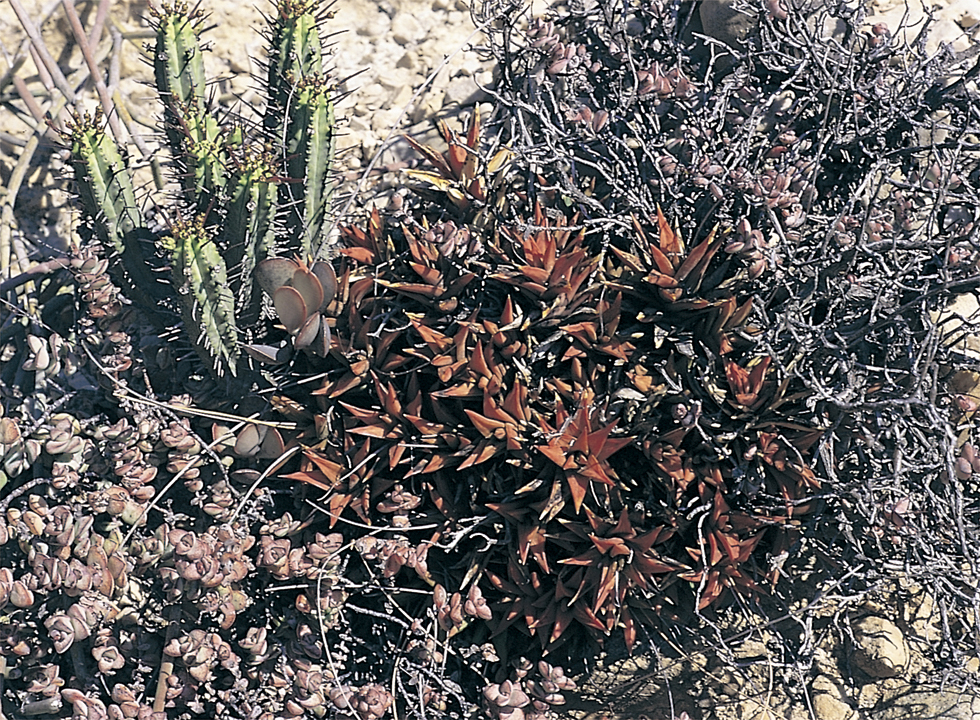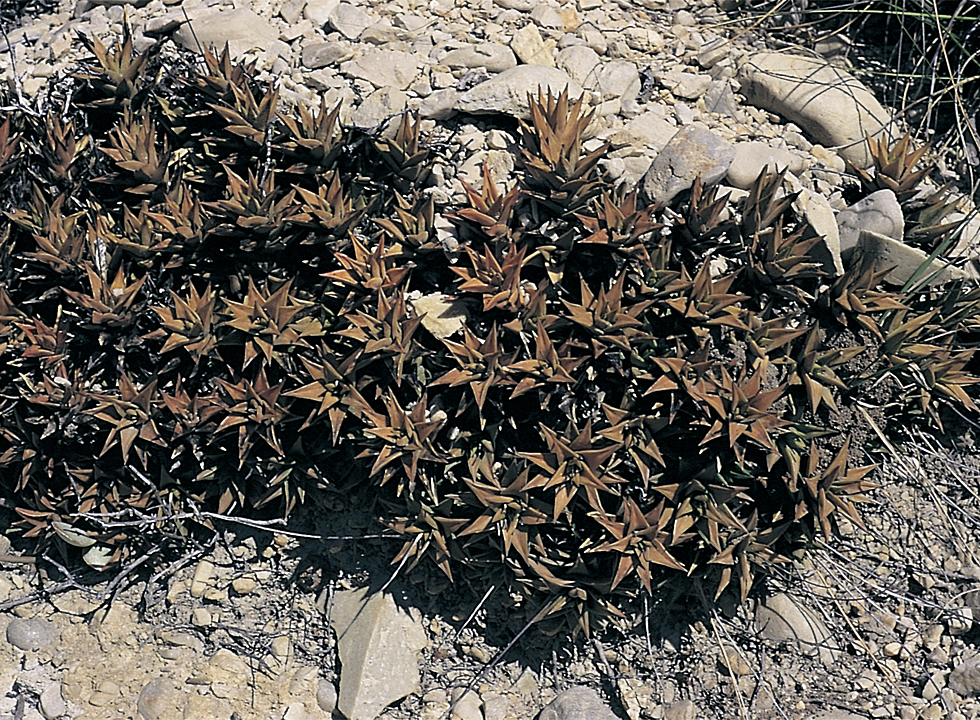52. Haworthia pungens M.B.Bayer spec. nov. Type: CAPE-3323 (Willowmore): Braamrivier, Joubertina (-DD), Bruyns 7090 (BOL, Holo.)
pungens: sharp-pointed
Rosette to 60 mm φ, caulescent, proliferating. Leaves many, arrangement occasionally trifarious, usually fivefarious, to 50 x 18 mm, spreading, smooth, rigid, sharp-pointed, green in shade, darkening and reddening in sunlight. Inflorescence simple, to 300 mm. Flowers tepals fused, tube straight, inner lower tepals revolute. (Haworthia viscosae simillima sed foliis plerumque cumepidermis omnino laevi et duriore apicique differt, plantae caulibus situ foliorum cum apicibus acutis plantam Astrolobae simulans.)
Odd plants from the Longkloof Valley between Uniondale and Humansdorp have appeared from time to time. One such collection was of H. viscosa with long slender leaves. However at one time there was a Poellnitzia-like plant in the greenhouse of the Albany Museum said to be from the Baviaanskloof. Recently P.V.Bruyns brought back specimens from the more southerly Langkloof, north of Joubertina, which he said resembled an Astroloba. Shortly thereafter Ernst van Jaarsveld also brought back specimens from north of Kareedouw. The two localities are about 30 kn apart. The Braamrivier locality is a small conglomerate outcrop bearing an assortment of succulents such as Crassula perfoliata and Euphorbia enopla, but in among Fynbos. The plants form clusters of stems which are less upright than for H. viscosa, up to 0,5 m in diameter. The lower leaves are mostly dead and the plants partly covered by the eroding conglomerate. The colouration is striking although from a distance the plants show up as conspicuous black bushes on the bare hot rocky slope. H. scabra also grows nearby and just off the main population, growing on a single rock about one metre in diameter were several specimens of this species, a single plant of the new species and five hybrid which were all different. At the Kareedouw locality, the rock was also conglomerate but without the other succulents. The clusters were much smaller than at Braamrivier and the habitat was also cooler and less hostile. Nearby was a small Haworthia in the mould of H. cooperi var. gordiana.
The significance of the species must be considerable. Dr M. Hayashi suggested at the Succulent Congress in Johannesburg in 1996, and in manuscript, that the genus Astroloba proceeded or evolved from the Robustipedunculares. However, this species is much more Astroloba-like. Its location in the Langkloof removes it entirely from the range of the Robustipedunculares and the flower is characteristic of the Hexangulares. H. viscosa grows about 15 km eastward from the Kareedouw locality where it co-occurs and hybridizes with H. fasciata. H. pungens cannot be confused with H. viscosa at all as the leaves are much more rigid and entirely smooth. It can be noted that the common hybrids between H. viscosa and H. glauca which are found north and west of the Groot Winterhoek mountains are also Astroloba-like. But I would not suggest that this hybrid is the origin of Astroloba nor of the new species.
Distribution: 3323 (Willowmore): Braamrivier, Joubertina (-DD), Bruyns 7090, Bayer 6725 (NBG). 3324 (Steytlerville): Joubertskraal (-CC), van Jaarsveld 15576, Bayer 6672 (NBG).


Haworthia pungens JDV97/103 Braamrivier. A strange admixture of succulents among fynbos. 
Haworthia pungens JDV97/103 Braamrivier. Plants are very dark coloured and reddish.
